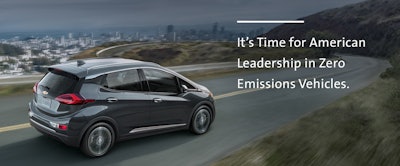
General Motors will file comments to the Safer Affordable Fuel-Efficient (SAFE) Vehicles Rule for Model Years 2021-2026 Passenger Cars and Light Trucks. In its comments, General Motors proposes the establishment of a National Zero Emissions Vehicle (NZEV) program to support a 50-state solution, promote the success of the U.S. automotive industry and preserve U.S. industrial leadership for years to come.
General Motors anticipates the NZEV program, as recommended, has the potential to place more than 7 million long-range EVs on the road by 2030, yielding a cumulative incremental reduction of 375 million tons of CO2 emissions between 2021 and 2030 over the existing ZEV program.
Quotes from Mark Reuss, executive vice president and president, Global Product Group and Cadillac:
- “General Motors has a vision of zero crashes, zero emissions and zero congestion. This is a bold vision and getting there will take bold actions.”
- “We believe in a policy approach that better promotes U.S. innovation and starts a much-needed national discussion on electric vehicle development and deployment in this country. A National Zero Emissions Program will drive the scale and infrastructure investments needed to allow the U.S. to lead the way to a zero emissions future.”
General Motors supports a nationwide program modeled on the existing ZEV program and provides these framework recommendations:
- Establish ZEV requirements (by credits) each year, starting at 7 percent in 2021 and increasing 2 percent each year to 15 percent by 2025, then 25 percent by 2030.
- Use of a crediting system modeled on the current ZEV program: credits per vehicle, based on EV range, as well as averaging, banking and trading.
- Requirements after 2025 linked to path toward commercially viable EV battery cell availability at a cost of $70/kWh and adequate EV infrastructure development.
- Establishment of a Zero Emissions Task Force to promote complementary policies.
- Program terminates when 25 percent target is met, or based on a determination that the battery cost or infrastructure targets are not practicable within the timeframe.
- Additional consideration for EVs deployed as autonomous vehicles and in rideshare programs.


















